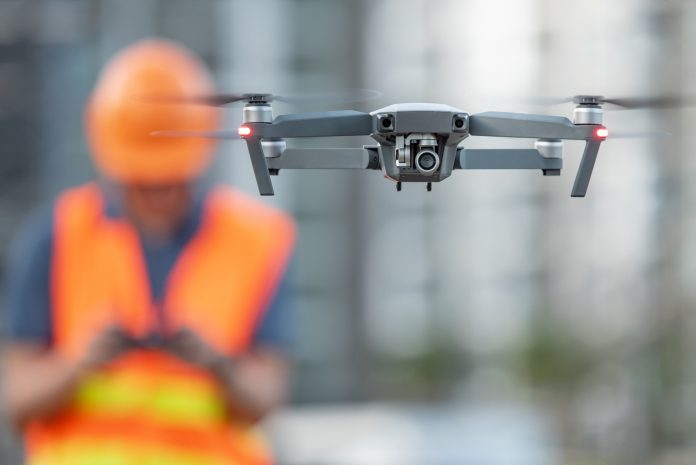What will our future cities look like and what issues do we need to consider now? Navpreet Atwal, partner at law firm Bootle Hadfield, looks at the legal implications of the increasing use of unmanned aircraft systems
The pandemic has been a particularly testing time but the one sector that has thrived in these difficult times is the technology sector. It is not just the Amazons and Telsas of this world but the nascent unmanned aircraft systems (UAS) (or drones) which have been soaring.
UAS have been in use for more than a decade but there are a number of restrictions both to manned and unmanned aircraft use. The construction sector has successfully navigated these restrictions to use drones to its advantage. Aerial views and spatial awareness provide a range of benefits to construction projects and this is just the beginning for drone use in the built environment.
In the last year, we saw drones used successfully in the medical delivery sector. Over time, this technology will develop to become an extension to existing public service infrastructure. It has the potential to transform the way we move and will redefine with way we interact with our built environment.
As unmanned aircraft systems become more integrated into our lives, the complex aviation and operational rules will need to be balanced with other legal/regulatory issues.
Airspace battle
If we are envisaging a society where anyone can order a drone taxi or order a takeaway delivered by drone, there will be hundreds of aircrafts in the air. Adopting a safe method of controlling air traffic management will be key.
Currently, air traffic is controlled through a control tower, who speak directly to pilots. This would not be feasible for UAS. Communication will need to be through the new concept of the Internet of Things (IoT), which brings connectivity to virtually everything via device-to-device communication.
The legislative framework governing unmanned aircraft systems and air traffic control will need to consider the different stakeholders involved. This includes not only manufacturers and operators of UAS but also other airspace users, such as recreational drone users. The Air Traffic Management & Unmanned Aircraft Bill will go some way in modernise UK airspace and drone corridors will need to be developed to overcome the barrier of unrestricted airspace where drones and general aviation share the skies.
Security and privacy
Privacy and security are a growing concern for today’s society. These are self-evident when discussing the use of UAS, which have data-capture capability through video cameras, microphones and GPS.
Use and storage of data is likely to be covered by existing data protection laws, especially where a commercial drone operator holds a permission for commercial operations allowing them to sell footage or images. The Information Commissioner’s Office (ICO) provides guidance on these issues but there remain gaps. How do we ensure protection against privacy breaches and other nefarious activities such as cybersecurity risks?
The answer could be in blockchain-based IoT. Data would be decentralised on the blockchain and secured through cryptography, preventing data from being altered. This ledger technology would enable encrypted secure communications and alleviate some concerns about security. We will see a greater partnership between aviation and mobile telecoms industry to support our future built environment.
Liability issues
In 2019 in Switzerland, a drone delivering lab samples to a medical facility crashed in close proximity to a children’s playpark. Thankfully, no one was injured but this highlights just one of the serious liability issues facing the UAS industry.
The following aspects will be key liability considerations for unmanned aircraft systems stakeholders and insurers:
- Liability for loss or damage.
- Liability for mid-air collisions.
- Liability for lost cargo.
- Intellectual property breaches and cyber threats.
As the industry evolves, drone manufacturers and operators will continue to face increasingly complex and high value exposure. Collaboration will be required between stakeholders to ensure the safe and responsible use of this technology along with comprehensive liability coverage.
Building design
Over the years, we have seen changes to how rooftops are used. Gone are the days when rooftops predominately housed plant equipment. If you look at aerial views of any major cities, you will see a significant number of green and entertaining space.
The next stage of the evolution will be a profound change in the design and construction of buildings. Rooftops will require landing pads, charging points and drone ports. Existing buildings will require adaptations to accommodate this infrastructure. All this will need to be balanced with the need for reducing noise pollution, emissions and ensuring privacy if drones are hoovering close to windows and private space.
Not only will the buildings themselves change but the way cities develop will transform. Growth and expansion will be less constrained to linear development like we have seen with traditional infrastructure such as rail and automobile. There is more likely to be organic growth in line with economical societal and cultural demands.
Conclusions
The possibilities of drones are radical and will permeate all aspects of the built environment. There are huge benefits, not least as we have seen in the medical sector, but also in the growth of our cities.
There will be fewer constraints afforded by linear growth and greater connectivity across communities, but this new environment is not without hurdles. All stakeholders, manufacturers, operators, consumers and policy makers will need to mitigate the real concerns of security, privacy, airspace usage and liability.
 Navpreet Atwal
Navpreet Atwal
Partner, construction
Tel: +44 (0)20 7629 7411
Twitter: BoodleHatfield
LinkedIn: Boodle Hatfield














